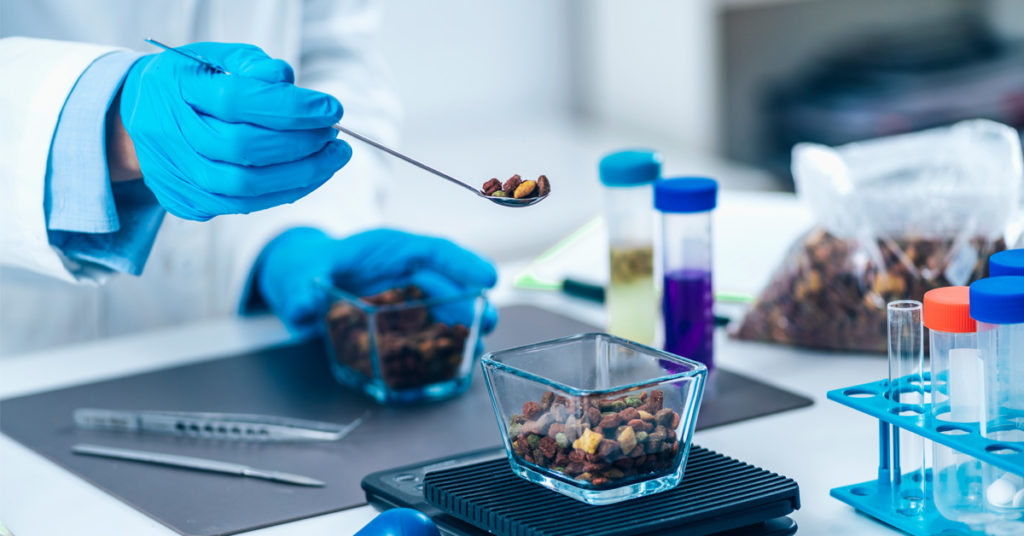Ready to enter the pet food market with your own private label brand? Here’s everything retailers need to know to manufacture a standout product.
Private label is one of the biggest pet food sales opportunities for retailers. But how do they actually make it happen? It starts with an idea. But it becomes reality with help from a pet food manufacturing partner.
You might already have some of the details worked out, like what kind of product you want to make, which tier of customers you want to serve (value vs. super premium), how much volume you need to produce and what you want your formula to include.
On the other hand, maybe all you know is that you’re ready to create a private brand – and that’s okay.
Either way, a pet food manufacturer can help you execute your ideas – or dream up the pet food product that’s right for you. Here’s how.
The Pet Food Manufacturing Process: 5 Steps
Step 1: Select a Private Label Pet Food Manufacturer
To create a pet food brand, you need a manufacturer on your side well before production.
A good partner will guide you through the entire pet food manufacturing process, from R&D and packaging design to production and distribution. A solid partnership will make the entire process a smooth one.
Step 2: Confirm Product Details
As mentioned, you might already have these details. But if you don’t, there are a few things you need to figure out.
Your pet food manufacturer can help you determine some of these factors, but you should make sure your new product aligns with their capabilities.
- Product type: What do you want to deliver to the marketplace?
- Product tier: What type of customers do you want to serve?
- Volume: How much do you want to make?
- Formula: What ingredients do you want to use and how do you want it to be formulated?
Once you have determined what you want to produce – be it a super premium dry dog food or premium baked treat – you’re ready to bring your concept to life.
Step 3: Get Quote
Make it official with your pet food manufacturing partner. Now that you’ve nailed down the pertinent details – including working with your partner to create the perfect formula, whether it’s a house formula or custom concept – you’re ready for a quote.
This quote should include everything you need to bring your private pet food brand to market, including:
- Product formulation
- Ingredients
- Volume
- Location
- Shipping needs
Step 4: Develop Packaging & Brand Attributes
Besides formulation, this is one of the more in-depth steps in the pet food manufacturing process. This is because your pet food packaging and brand attributes are directly tied to your product’s success on the shelf.
To persuade your retail customers to convert from their favorite puppy food to your new offering, you will have to be creative in the packaging department. But there are some other technical aspects to consider:
Bag Size
The type of product you’re bringing to market, the shape and size of your formula, and the density and volume of your pet food will impact this decision.
When kibble comes out of the extruder and is exposed to oxygen, it can expand. This results in a lighter, fluffier kibble (less dense) that also takes up more room in a bag. So, it’s important to be aware of the time your product spends in the extruder and the resulting density. That way, you end up with a bag that does not appear too full or too empty.
Bag Style
There are many different bag styles to choose from, depending on the volume of your pet food:
- Stand up pouch: A popular option for treat packages weighing 1-8 lbs.
- Quad seal bag: For small and large-volume bags weighing 3-40 lbs., offering 4 panels.
- Flat bottom bag: For bags weighing 2-25 lbs., offering a larger design canvas.
- Pinch bottom bag: For larger-volume bags, typically placed on the bottom shelf.
Packaging Materials and Design
When a product is still earning favor with its target customers, first impressions can mean a lot.
And these first impressions are based on two primary factors:
- Practicability
- Visual and tactile appeal
These options help you make the most of each:
- Paper: The original go-to choice for pet food packaging, but being replaced by other materials due to supply and functionality concerns.
- Plastic: Offers a level of freshness that other materials struggle to emulate.
- Polywoven: Multi-layered pet food bags work well for large packages of dry kibble.
- Matte: Matte and soft-touch surfaces are increasing in popularity due to the visual and tactile aesthetic.
You also might consider incorporating other bag features to help maintain freshness, such as easy-to-use sliders, Velcro (or other hook-to-hook) products, or press-to-close zippers.
Compliance
Your bag should appeal to not only consumers but also to regulatory authorities. Most states follow AAFCO model regulations for writing clear pet food labels. This is yet another area your pet food manufacturer partner should be able to help you with.
Step 5: Manufacturing
The last step of the pet food manufacturing process is the manufacturing itself. At this point, your manufacturer will take over and see through the production and distribution of your product.
But keep in mind, before actual production can begin, your manufacturer should perform palatability tests and production trials. These quality assurance tests help ensure that you achieve a high-quality product that promotes palatability and digestibility while optimizing density and speed of production.
Conclusion
Successful private label products are built on successful manufacturing partnerships. So, don’t skip the first step of the process. Having an experienced and flexible pet food manufacturer can help make sure your final product aligns with your overarching vision.
Alphia helps private label brands develop market-leading pet food from concept to shelf. Let us know about your pet food needs.
